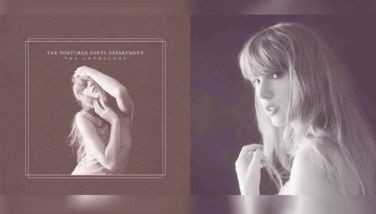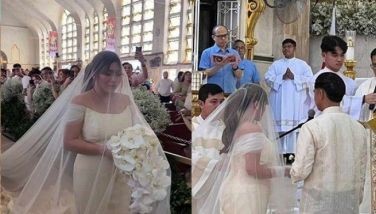Protecting the rights of artists
Lawyer Pablo Gancayco, senior partner of the Gancayco, Balasbas & Associates Law Offices, has been elected the new president of the Intellectual Property Association of the Philippines (IPAP). He and the other new IPAP officers were inducted into office by director-general Ric Blancaflor of the Intellectual Property Office.
Gancayco has been in IP practice locally and internationally for almost 25 years now. He is married to fellow lawyer, Dot Gancayco, with whom he has two children Jon (24) and Mika (13).
The IPAP is the lead organization responsible for handling, among others, the registration and conflict resolution of intellectual property rights locally. It is the only organization of lawyers engaged in the practice of Intellectual Property Law in the Philippines which covers trademarks and brand names, invention patents, and copyrights of musical compositions, movies, and other artistic and literary works, among others.
So what is intellectual property? An intellectual property (IP) refers to creations of the mind like inventions, literary and artistic works, and symbols, names, images, and designs used in commerce (as defined by the world intellectual property organization).
The Intellectual Property Code was enacted on June 6, 1997 and became effective on Jan. 1, 1998. The present IP Code was ratified to protect and secure the exclusive rights of scientists, inventors, artists and other gifted citizens to their intellectual property and creations. It was also enacted to streamline administrative procedures of registering intellectual properties and to enhance the enforcement of intellectual property rights in the Philippines.
The Intellectual Property Law is used when the subject involved is included in property rights consisting of Copyright and Related Rights, Trademarks and Service Marks, Geographic Indications, Industrial Designs, Patents, Layout-Designs (Topographies) of Integrated Circuits and Protection of Undisclosed Information (TRIPS).
According to Gancayco, an artist or author is protected by the IP law from the moment of the creation of his intellectual property (i.e. books and paintings) but craftsmen are protected only from the time they registered their work with the Intellectual Property Office.
IP law ranges from the registration of the intellectual properties to the protection and enforcement of liability from the violation of the rights arising from these intellectual properties. IP law applies to writings, inventions to industrial designs as long as the criteria/ requirements provided by the IP law are met.
Through the E-Commerce Act of 2000 (RA No. 8792), electronic media is now a protected intellectual property.
Plagiarism is not defined nor included strictly in our laws but since it is closely related with the definition of copyright infringement, it is submitted that our law in copyright infringement is sufficient to cover acts of plagiarism.
Gancayco says that an artist is not literally defined by the IP law. What is defined by the law is the term artistic works which imply that every person, artist or not, who has created, written, drawn or painted an artistic work is an artist in the eyes of the law. Movies are also not technically defined by the law but are merely described as audio-visual works and cinematographic works or any process for making audio-visual recordings. Musical composition is also not literally defined. The law only provides that musical composition, with or without words, is protected.
Movies are audio-visual works and Section 178.5 of the IP Code states that the copyright shall belong to the producer, the author of the scenario, the composer of the music, the film director and the author of the work so adapted. However, subject to contrary or other stipulations among the creators, the producers shall exercise the copyright to an extent required for the exhibition of the work in any manner except for the right to collect performing license fees for the performance of musical compositions, with or without words, which are incorporated into the work.
 IPAP’s new officers and past presidents: (standing, from left) Lawyers Maria Teresa Trinidad, Nini Priscilla Sison-Ledesma, Enrique Manuel, C. Risel Castillo-Taleon, Alex Ferdinand Fider, Antonio Audie Bucoy, Bienvenido Somera Jr., Arturo del Rosario Jr., Ramon Esguerra, new president Gancayco, Dino Vivencio Tamayo, Rogelio Nicandro, Augusto San Pedro. (Seated, from left) Manuel Cases Jr., Emeterio Soliven, Judge Cesar Cruz, Lorna Patajo-Kapunan, director-general Ricardo Blancaflor, Alonzo Ancheta, Aleli Angela Quirino, Maria Trinidad Villareal, Paula Katherina Gan-Rongavilla and Sonya Margarita Benemerito-Castillo
IPAP’s new officers and past presidents: (standing, from left) Lawyers Maria Teresa Trinidad, Nini Priscilla Sison-Ledesma, Enrique Manuel, C. Risel Castillo-Taleon, Alex Ferdinand Fider, Antonio Audie Bucoy, Bienvenido Somera Jr., Arturo del Rosario Jr., Ramon Esguerra, new president Gancayco, Dino Vivencio Tamayo, Rogelio Nicandro, Augusto San Pedro. (Seated, from left) Manuel Cases Jr., Emeterio Soliven, Judge Cesar Cruz, Lorna Patajo-Kapunan, director-general Ricardo Blancaflor, Alonzo Ancheta, Aleli Angela Quirino, Maria Trinidad Villareal, Paula Katherina Gan-Rongavilla and Sonya Margarita Benemerito-Castillo If somebody copied a scene in a movie, the director can sue depending on how a scene is copied. For example, if a specific movie clip was used by another movie without proper attribution, then the director/producer can sue because economic rights have been violated.
Likewise, if the author was given proper attribution when the written work was used in the movie, he cannot sue but he has to be properly renumerated. There are limitations on copyright and the same are enumerated under Section 184, 187, 188, 189 and 190 of the IPCode. There is also the Fair Use doctrine under Section 185 of the same code.
There have been many cases wherein the different remedies for infringement have been implemented, such as obtaining injunction to restrain infringers, payment of damages in civil cases filed, impounding and /or destroying infringing articles. In some cases, some have been criminally held liable for unfair competition.
A new composer or writer can protect his works by registering his copyright with the National Library or with the Intellectual Property Office and any of its satellite offices. This is done by depositing a copy of it with the said institutions after the first public dissemination of the said works. After this, a certificate of deposit shall be issued in their favor for their protection.
The intellectual property right has an expiry date. With Patents, its 20 years from the time of filing date of application. With the trademarks, 10 years subject to indefinite renewals for another 10 years each. For Copyright — during the lifetime of the author until 50 years from the time of his death; work of applied art for 25 years from the date of making; for photographic works 50 years from the publication of work or from creation if unpublished; for broadcasting – 20 years from date of broadcast.
It’s about time artists and their works are protected by laws of the country. But it doesn’t stop there. Artists must move to claim their fundamental right of owning intellectual properties.
(IPO office is located at #28 Upper McKinley Road,McKinley Hill Town Center, Fort Bonifacio, Taguig City.)
- Latest
- Trending

























 Exclusive
Exclusive






